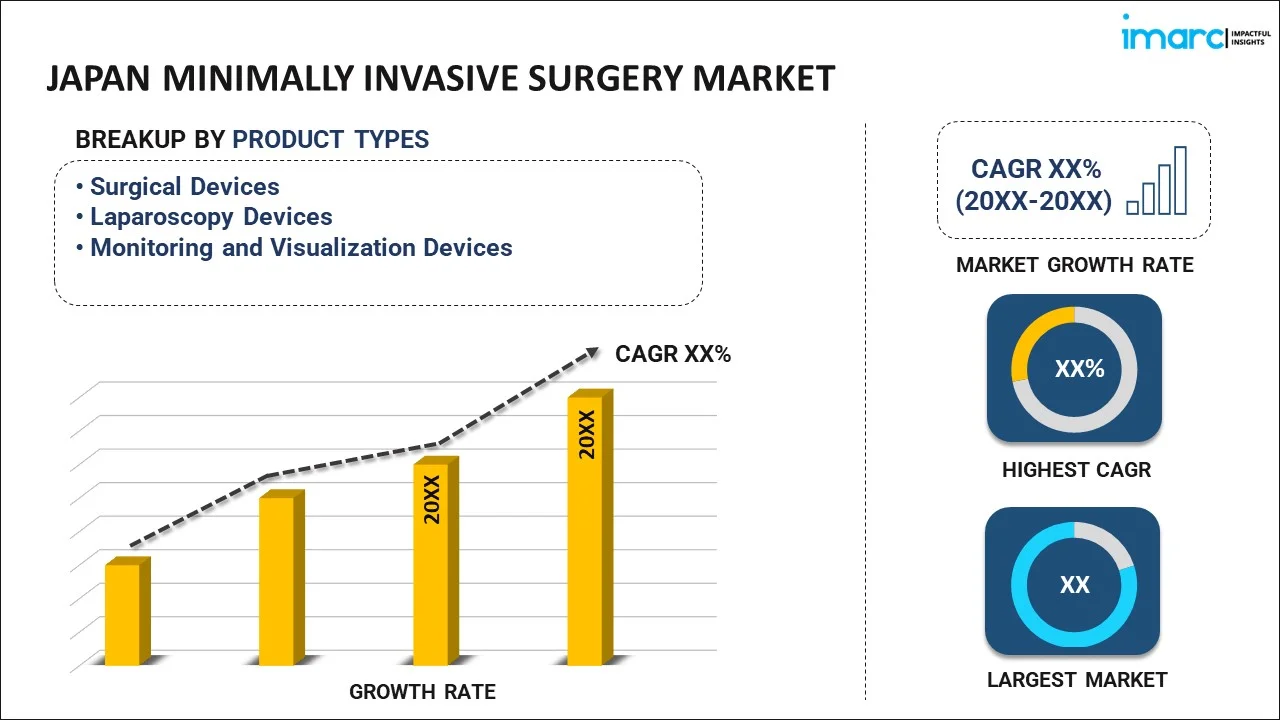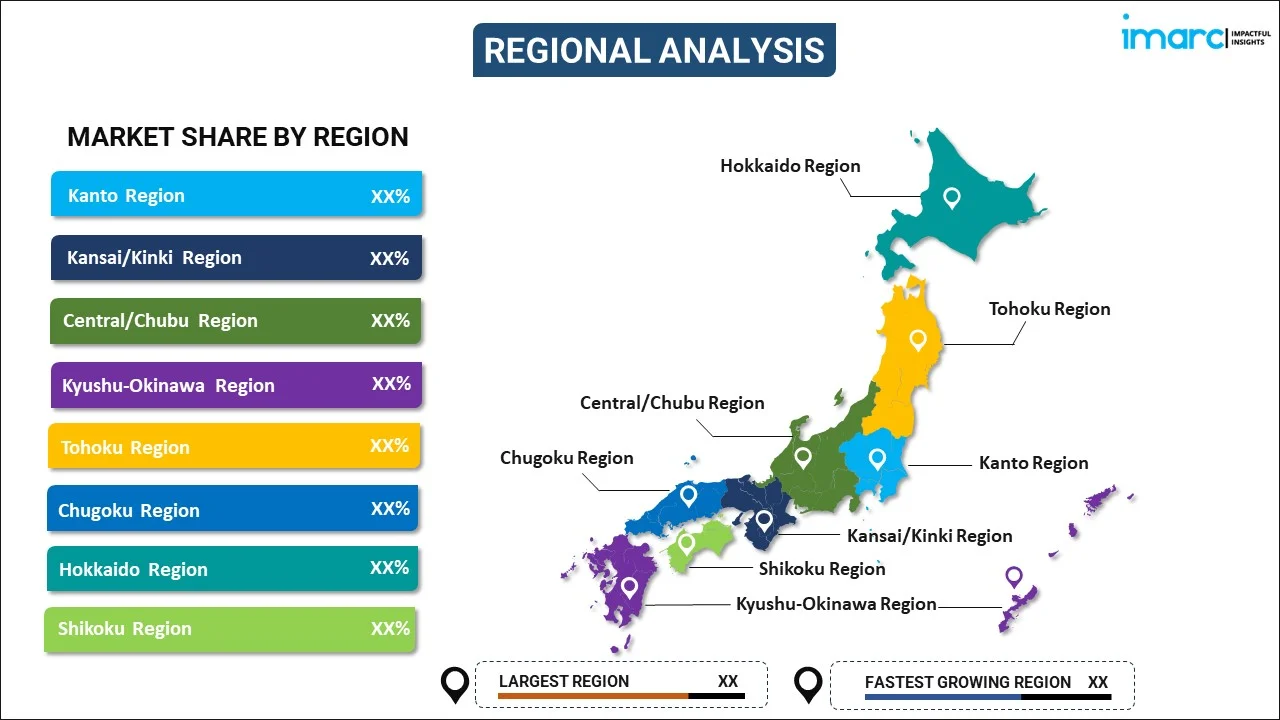
Japan Minimally Invasive Surgery Market Report by Product Type (Surgical Devices, Laparoscopy Devices, Monitoring and Visualization Devices), Application (Bariatric Surgery, Breast Surgery, Cardiac Surgery, Cosmetic Surgery, Gastrointestinal Surgery, Gynaecological Surgery, Orthopedics and Spine Surgery, Thoracic Surgery, and Others), End User (Hospitals, Clinics, and Others), and Region 2025-2033
Market Overview:
Japan minimally invasive surgery market size reached USD 2.5 Billion in 2024. Looking forward, IMARC Group expects the market to reach USD 4.5 Billion by 2033, exhibiting a growth rate (CAGR) of 6.08% during 2025-2033. The inflating need for safer alternative to conventional open surgeries, along with the development of minimally invasive surgical equipment, is primarily driving the market growth.
|
Report Attribute
|
Key Statistics
|
|---|---|
|
Base Year
|
2024 |
|
Forecast Years
|
2025-2033
|
|
Historical Years
|
2019-2024
|
| Market Size in 2024 | USD 2.5 Billion |
| Market Forecast in 2033 | USD 4.5 Billion |
| Market Growth Rate (2025-2033) | 6.08% |
Minimally invasive surgery employs surgical methods that aim to reduce the size and quantity of surgical incisions, employing small instruments, cameras, and illumination. In comparison to conventional open surgery, this approach is notably safer, leading to fewer complications, accelerated recovery times, reduced blood loss, favorable outcomes, and shorter hospital stays. Consequently, these procedures are garnering increasing favor among both medical practitioners and patients worldwide. They find extensive application in a range of surgical disciplines, including cardiothoracic, orthopedic, vascular, and neurological procedures.
Japan Minimally Invasive Surgery Market Trends:
The Japan minimally invasive surgery market is experiencing notable growth, primarily propelled by the rising incidence of chronic and lifestyle-related diseases, including cancer and obesity. These conditions are often linked to sedentary lifestyles and evolving dietary preferences. Consequently, there has been an upswing in the adoption of various weight loss surgical interventions, such as bariatric surgery and gastric banding, which employ minimally invasive (MI) techniques. Furthermore, a growing health consciousness among the population has further bolstered the utilization of minimally invasive procedures, which is acting as another significant growth-inducing factor. Apart from this, the increasing aging demographic in Japan has contributed to a surge in cardiac and orthopedic complications, necessitating a greater demand for MI surgical interventions. Moreover, manufacturers in the medical industry are actively engaged in research and development (R&D) efforts to introduce technological innovations to the field of surgery. For instance, the integration of robotic technology into MI surgeries has also led to enhanced precision and increased success rates. Additionally, advanced surgical systems offer improved outcomes by providing a three-dimensional (3D) high-definition view of the surgical area, fostering a positive outlook for the market's growth. Apart from this, numerous technological advancements in the fields of telemedicine and medical robotics are anticipated to fuel the regional market in the coming years.
Japan Minimally Invasive Surgery Market Segmentation:
IMARC Group provides an analysis of the key trends in each segment of the market, along with forecasts at the country level for 2025-2033. Our report has categorized the market based on product type, application, and end user.
Product Type Insights:

- Surgical Devices
- Laparoscopy Devices
- Monitoring and Visualization Devices
The report has provided a detailed breakup and analysis of the market based on the product type. This includes surgical devices, laparoscopy devices, and monitoring and visualization devices.
Application Insights:
- Bariatric Surgery
- Breast Surgery
- Cardiac Surgery
- Cosmetic Surgery
- Gastrointestinal Surgery
- Gynaecological Surgery
- Orthopedics and Spine Surgery
- Thoracic Surgery
- Others
A detailed breakup and analysis of the market based on the application have also been provided in the report. This includes bariatric surgery, breast surgery, cardiac surgery, cosmetic surgery, gastrointestinal surgery, gynaecological surgery, orthopedics and spine surgery, thoracic surgery, and others.
End User Insights:
- Hospitals
- Clinics
- Others
The report has provided a detailed breakup and analysis of the market based on the end user. This includes hospitals, clinics, and others.
Regional Insights:

- Kanto Region
- Kansai/Kinki Region
- Central/ Chubu Region
- Kyushu-Okinawa Region
- Tohoku Region
- Chugoku Region
- Hokkaido Region
- Shikoku Region
The report has also provided a comprehensive analysis of all the major regional markets, which include Kanto Region, Kansai/Kinki Region, Central/ Chubu Region, Kyushu-Okinawa Region, Tohoku Region, Chugoku Region, Hokkaido Region, and Shikoku Region.
Competitive Landscape:
The market research report has also provided a comprehensive analysis of the competitive landscape in the market. Competitive analysis such as market structure, key player positioning, top winning strategies, competitive dashboard, and company evaluation quadrant has been covered in the report. Also, detailed profiles of all major companies have been provided.
Japan Minimally Invasive Surgery Market Report Coverage:
| Report Features | Details |
|---|---|
| Base Year of the Analysis | 2024 |
| Historical Period | 2019-2024 |
| Forecast Period | 2025-2033 |
| Units | Billion USD |
| Scope of the Report | Exploration of Historical Trends and Market Outlook, Industry Catalysts and Challenges, Segment-Wise Historical and Future Market Assessment:
|
| Product Types Covered | Surgical Devices, Laparoscopy Devices, Monitoring and Visualization Devices |
| Applications Covered | Bariatric Surgery, Breast Surgery, Cardiac Surgery, Cosmetic Surgery, Gastrointestinal Surgery, Gynaecological Surgery, Orthopedics and Spine Surgery, Thoracic Surgery, Others |
| End Users Covered | Hospitals, Clinics, Others |
| Regions Covered | Kanto Region, Kansai/Kinki Region, Central/ Chubu Region, Kyushu-Okinawa Region, Tohoku Region, Chugoku Region, Hokkaido Region, Shikoku Region |
| Customization Scope | 10% Free Customization |
| Post-Sale Analyst Support | 10-12 Weeks |
| Delivery Format | PDF and Excel through Email (We can also provide the editable version of the report in PPT/Word format on special request) |
Key Questions Answered in This Report:
- How has the Japan minimally invasive surgery market performed so far and how will it perform in the coming years?
- What has been the impact of COVID-19 on the Japan minimally invasive surgery market?
- What is the breakup of the Japan minimally invasive surgery market on the basis of product type?
- What is the breakup of the Japan minimally invasive surgery market on the basis of application?
- What is the breakup of the Japan minimally invasive surgery market on the basis of end user?
- What are the various stages in the value chain of the Japan minimally invasive surgery market?
- What are the key driving factors and challenges in the Japan minimally invasive surgery?
- What is the structure of the Japan minimally invasive surgery market and who are the key players?
- What is the degree of competition in the Japan minimally invasive surgery market?
Key Benefits for Stakeholders:
- IMARC’s industry report offers a comprehensive quantitative analysis of various market segments, historical and current market trends, market forecasts, and dynamics of the Japan minimally invasive surgery market from 2019-2033.
- The research report provides the latest information on the market drivers, challenges, and opportunities in the Japan minimally invasive surgery market.
- Porter's five forces analysis assist stakeholders in assessing the impact of new entrants, competitive rivalry, supplier power, buyer power, and the threat of substitution. It helps stakeholders to analyze the level of competition within the Japan minimally invasive surgery industry and its attractiveness.
- Competitive landscape allows stakeholders to understand their competitive environment and provides an insight into the current positions of key players in the market.
Need more help?
- Speak to our experienced analysts for insights on the current market scenarios.
- Include additional segments and countries to customize the report as per your requirement.
- Gain an unparalleled competitive advantage in your domain by understanding how to utilize the report and positively impacting your operations and revenue.
- For further assistance, please connect with our analysts.
 Inquire Before Buying
Inquire Before Buying
 Speak to an Analyst
Speak to an Analyst
 Request Brochure
Request Brochure
 Request Customization
Request Customization




.webp)




.webp)












